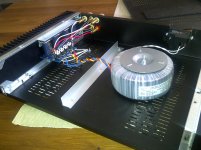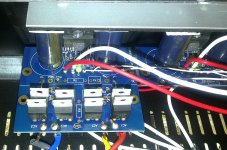Hello Peter,
once you´ve announced upgrades to be coming concerning the dac
incl. external psu. Do you have an idea when the time has come to
publish?
Here you are: http://www.diyaudio.com/forums/audio-sector/187748-pushing-limits-tda1543-nos-dac.html
Upstream hiss and buzz, and too much gain: input attenuation or gain reduction?
My source is a DCX-2496 with Jan Didden's active mod (http://www.linearaudio.nl/6chan-1.htm), which has a peak output of 5V RMS. I believe (correct me if I'm wrong) that Peter's LM3875 GC is 1V for max output @ 33dB gain.
The LM3875s are running my tweets which are quite efficient (112dB 1W/1m; 12 Ohm); lows (102dB/8 Ohm) are powered by a Rotel RB 980-BX. Current settings on the modded DCX are Low: 0dB, Hi: -13db, implying 30dB gain on the Rotel, vs 33dB for the GCs (or perhaps I just like bass .
.
Since moving from a noisy city to a quiet village, two previously-tolerable elements have become too apparent: hiss from the DCX itself (not - I believe - from Jan's mod), and the buzz from the Sedlbauer 22V/300VA toroids I used on the GCs.
They buzz merrily whether connected to the rectifier boards or not, and I intend to try r-cores from Selectronic (any comments?).
Closest matches to Peter's recommendation are: 120VA 18V or 24V; 300VA 21V or 24V. Given the efficiency of the tweets, can I get away with 120VA (they're half the price of the 300VAs)? Would 24V better suit the 12 Ohm load?
Assuming the r-cores don't buzz, what's the best way to cure the hiss? I've clearly got a gain structure issue and ideally should be running the DCX at 0dB on high and low, but should I reduce the GC gain, or attenuate the input?
Per www.audiosector.com/nigc_kit-users_guide.pdf: "To lower the gain, increase the value of R3" which leads to 1,100 Ohms for 20dB - this will reduce the inbound noise by a welcome 13dB, right?
Can I just add a series resistor on the input to achieve the same, or do I need a voltage divider? What values? I'm confused...
Any advice appreciated!
Best wishes,
Steve
My source is a DCX-2496 with Jan Didden's active mod (http://www.linearaudio.nl/6chan-1.htm), which has a peak output of 5V RMS. I believe (correct me if I'm wrong) that Peter's LM3875 GC is 1V for max output @ 33dB gain.
The LM3875s are running my tweets which are quite efficient (112dB 1W/1m; 12 Ohm); lows (102dB/8 Ohm) are powered by a Rotel RB 980-BX. Current settings on the modded DCX are Low: 0dB, Hi: -13db, implying 30dB gain on the Rotel, vs 33dB for the GCs (or perhaps I just like bass
Since moving from a noisy city to a quiet village, two previously-tolerable elements have become too apparent: hiss from the DCX itself (not - I believe - from Jan's mod), and the buzz from the Sedlbauer 22V/300VA toroids I used on the GCs.
They buzz merrily whether connected to the rectifier boards or not, and I intend to try r-cores from Selectronic (any comments?).
Closest matches to Peter's recommendation are: 120VA 18V or 24V; 300VA 21V or 24V. Given the efficiency of the tweets, can I get away with 120VA (they're half the price of the 300VAs)? Would 24V better suit the 12 Ohm load?
Assuming the r-cores don't buzz, what's the best way to cure the hiss? I've clearly got a gain structure issue and ideally should be running the DCX at 0dB on high and low, but should I reduce the GC gain, or attenuate the input?
Per www.audiosector.com/nigc_kit-users_guide.pdf: "To lower the gain, increase the value of R3" which leads to 1,100 Ohms for 20dB - this will reduce the inbound noise by a welcome 13dB, right?
Can I just add a series resistor on the input to achieve the same, or do I need a voltage divider? What values? I'm confused...
Any advice appreciated!
Best wishes,
Steve
This is a common problem if you run the DCX direct into an amplifier, so you should run it at maximum output and attenuate it to the right level using a resistive divider. That adds its own noise, but insignificant compared to the DCX. The hiss usually does not scale with output level for the DCX, and is due to poor layout and component selection internally.
Modded units really help with this problem. I'm not sure what Jan's mod is like, but it should already be a lot better than the stock unit.
Modded units really help with this problem. I'm not sure what Jan's mod is like, but it should already be a lot better than the stock unit.
Thank you for the rapid replies.
From my meagre stock of decent resistors I've come up with 10k/1k for the divider, (based on recommendations at Voltage Dividers and Attenuators) for 20.8dB attenuation.
I'm guessing 10k input impedance of the GC.
Does this seem right?
From my meagre stock of decent resistors I've come up with 10k/1k for the divider, (based on recommendations at Voltage Dividers and Attenuators) for 20.8dB attenuation.
I'm guessing 10k input impedance of the GC.
Does this seem right?
Can I just add a series resistor on the input to achieve the same, or do I need a voltage divider? What values? I'm confused...
Referring to a schematic here: http://www.diyaudio.com/forums/audi...cial-gainclone-kit-building-instructions.html and considering increasing R3 value, further gain adjustment is best done with increasing the value of R1.
You can go as high as 1k6 for R3. Also to avoid excessively large series resistor values (R1), R2 can be reduced as well. Just try to keep R1 +R2 around 20k or so.
Last edited:
Are you referring to my "limitless" DAC? 
The input receiver can be certainly bypassed and I2S output from a transport connected directly to the DAC.
The matched TDA1543 are only required when signal is fed directly into transformers (no coupling caps).
http://www.diyaudio.com/forums/audio-sector/187748-pushing-limits-tda1543-nos-dac.html
The input receiver can be certainly bypassed and I2S output from a transport connected directly to the DAC.
The matched TDA1543 are only required when signal is fed directly into transformers (no coupling caps).
http://www.diyaudio.com/forums/audio-sector/187748-pushing-limits-tda1543-nos-dac.html
Referring to a schematic here: http://www.diyaudio.com/forums/audi...cial-gainclone-kit-building-instructions.html and considering increasing R3 value, further gain adjustment is best done with increasing the value of R1.
You can go as high as 1k6 for R3. Also to avoid excessively large series resistor values (R1), R2 can be reduced as well. Just try to keep R1 +R2 around 20k or so.
Thank you, Peter, for the prompt feedback.
With a cheapo 20k (actually 19k) pot, I've arrived at R1=16k; R2=3k for ~16dB input attenuation. I can now run the DCX at full stretch.
Moreover, I found that this also greatly reduced the noise heard at speaker from the buzzing transformer (whether the source was connected or not). Why should this be?
They are now the main source of noise, which brings me back to my earlier questions: would 120VA suffice for this application, and does anyone have experience with r-cores?
Thanks again,
Steve
Thank you, Peter, for the prompt feedback.
With a cheapo 20k (actually 19k) pot, I've arrived at R1=16k; R2=3k for ~16dB input attenuation. I can now run the DCX at full stretch.
Moreover, I found that this also greatly reduced the noise heard at speaker from the buzzing transformer (whether the source was connected or not). Why should this be?
They are now the main source of noise, which brings me back to my earlier questions: would 120VA suffice for this application, and does anyone have experience with r-cores?
Thanks again,
Steve
Hi guys,
Cool, I have the same setup, so a DCX (with Jan's active output stage) and the LM3875 premium kit's. Also, I experience the exact same problems. A slight buzz of the transformer and very low gain on the amps. So setting R1 to 16k and R3 to 3k correcting these issues sound good, but will take some time to implement. Since I have some nice 20k resistors laying around and have R1 not installed.... what would be the gain improvement if I just put them on the position for R1 and leave R3 680R?
Cheers,
Mark.
Hi guys,
Cool, I have the same setup, so a DCX (with Jan's active output stage) and the LM3875 premium kit's. Also, I experience the exact same problems. A slight buzz of the transformer and very low gain on the amps. So setting R1 to 16k and R3 to 3k correcting these issues sound good, but will take some time to implement. Since I have some nice 20k resistors laying around and have R1 not installed.... what would be the gain improvement if I just put them on the position for R1 and leave R3 680R?
Cheers,
Mark.
I guess I wasn't awake earlier this morning.... Steve's problem is to much gain as I have way to little. Also increasing values for R1 and 3 didn't sound logical for increasing gain.....
Cheers,
Mark.
Gain problems
Hi Peter,
As discussed before, the amp sounds good, however I have very low gain on the LM3875's. See pics for my setup.
Help is highly appreciated as I can't figure out what's wrong.....
Cheers,
Mark.
Hi Peter,
As discussed before, the amp sounds good, however I have very low gain on the LM3875's. See pics for my setup.
Help is highly appreciated as I can't figure out what's wrong.....
Cheers,
Mark.
Attachments
Hi Peter,
As discussed before, the amp sounds good, however I have very low gain on the LM3875's. See pics for my setup.
Help is highly appreciated as I can't figure out what's wrong.....
Cheers,
Mark.
Found the issue..... I accidently put the 220R resistors on the feedback. Replaced them with the 22k and gain is as it should be
LM4780 Kit Low Audio
I have this kit assembled currently running on just one half of two 28VCT transformers until my dual secondary toroid shows up.
What is happening is the audio level is very low (almost non existent in the vocal range). When I turn up the source volume (Blackberry) I get bad crackling distortion.
What might cause this issue?
Thanks
I have this kit assembled currently running on just one half of two 28VCT transformers until my dual secondary toroid shows up.
What is happening is the audio level is very low (almost non existent in the vocal range). When I turn up the source volume (Blackberry) I get bad crackling distortion.
What might cause this issue?
Thanks
Peter,
I built the stereo GC LM3875.
I wonder if there is difference in stereo, dual-mono and monoblock in listening and in building scheme. Why did you recommend for monoblock (I read about it in an old post)?
Is the GC premium kit ready for monoblock? What do I need to built monoblock (may be from my current stereo as I still have a spare set of PS: rectifier board, diods and caps).
What if I want to listen to stereo using dual mono or monoblock? Any additional modification or parts/components or connections need to be used in this case?
Thanks and Regards,
HT
I built the stereo GC LM3875.
I wonder if there is difference in stereo, dual-mono and monoblock in listening and in building scheme. Why did you recommend for monoblock (I read about it in an old post)?
Is the GC premium kit ready for monoblock? What do I need to built monoblock (may be from my current stereo as I still have a spare set of PS: rectifier board, diods and caps).
What if I want to listen to stereo using dual mono or monoblock? Any additional modification or parts/components or connections need to be used in this case?
Thanks and Regards,
HT
- Status
- This old topic is closed. If you want to reopen this topic, contact a moderator using the "Report Post" button.
- Home
- More Vendors...
- Audio Sector
- AudioSector-chip amp kits, dacs, chassis

